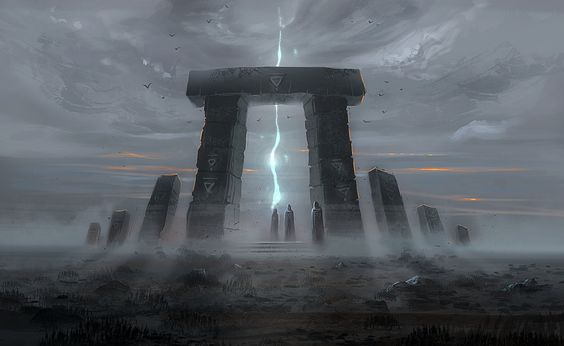The Fascinating Power of Dolmens & Menhirs, Ancient Megalithic Wonders

Monoliths, also referred to as menhirs, dolmens or obelisks are upright stones that have been used to create impressively -mysterious— structures all around the world.
These massive, fascinating ancient monuments can appear on their own, or as part of a group.
In the long sections of Mankind’s lost history, we must look at the time when ancient cultures managed to erect –somehow—huge megalithic construction using blocks of stone weighing from 1 to up to 100’s of tons.
Ancient mankind raised different kinds of megalithic blocks of stone arranging them as well as they could, taking advantage of certain peculiarities that some stones offered.
The ‘primitive’ techniques –sarcasm— allowed ancient cultures to move, place and position different rocks arranging them in specifics orders which, according to mainstream scholars, were consistent wth the thoughts, beliefs, and convictions of ancient man.
But what if ancient mankind knew something more about Dolmens and Menhirs that what we know nothing of today?
Is it possible that some of these megalithic structures were individually placed on our planet in order to take advantage of Earth’s natural energies? Is it possible that ancient cultures were aware of the existence of not only Earth’s energies, but of powers that originate deep inside the universe?
In the distant past, throughout centuries, ancient cultures raised some monuments that today receive a number of different denominations ranging from “Stonehenge’, ‘dolmens’,’ barrows’ and ‘menhirs’.
Many people will agree that most of these lithic buildings have a magical and metaphysical sense.
Each monument was erected in a particular order and had a meaning that today mainstream scholars are unable to decipher.
These fascinating megalithic construction works are notable for two main things.
First of all, their size was beyond fascinating and secondly they were built thousands of years ago.
Today, researchers estimate that many of the megalithic monuments around the globe are the product of an ancient civilization that had the ability to erect such monuments as far as 8,000 B.C.
Gobekli Tepe, for example, is one of the most fascinating ancient structures ever raised by ancient man.
Located on a remote hilltop in southern Turkey is one of the oldest (if not oldest) ancient megalithic temples on our planet.
There, intricate massive stone pillars arranged into a set of rings stand tall and proud telling a millennia-old story when different civilizations ruled the over the planet.
The massive stones were believed to have been carved by Neolithic hunter-gatherers some 12,000 years ago, even though recent evidence points towards the fact that Göbekli Tepe was in fact built by a far more advanced society than researchers are willing to accept.
While Göbekli Tepe and Stonehenge are just some of the examples of megalithic buildings, the megalithic conception spread out to Asia, Europe, and Even the Americas.
In some regions, the megaliths gained greater significance than others, as is the case of Wales, Scotland, and England.
In Ireland and Scotland, hundreds of these monuments still stand tall, and many of these are hidden beneath the surface, waiting to be found and admired by modern society.
Looking at Nordic countries, we will see that many similar structures are found in Sweden, Norway, Denmark and even in Germany but if we venture out south, we will find similar structures in Portugal and Spain.
Interestingly, in France alone there are over five thousand dolmens and a large number of menhirs spread across the country.
The sheer number of these structures gives uns an idea about the importance of these ancient structures and the important role they placed in early society.
The standing stone of Er-Grah is one of the most fascinating yet unsung wonders of the ancient world. It is considered by mans as the largest megalith ever erected in history and was raised in France (Brittany) sometime around 4,700 B.C.
This fascinating ancient megalith weighed 280 tons, meaning that even modern machinery would find it challenging to move and erect.
It is believed that Er-Grah stood for 700 years before breaking into four pieces at around 4000 BCE.
It is as if megalithic structures were a global phenomenon before ancient cultures started erecting giant pyramids around the globe.
Many people firmly believe that menhirs had a magical and metaphysical connotation, like dolmens or tumuli, even though their meaning differed, since menhirs acted as a catalyst for telluric and cosmic energies since part of their structure was buried into the ground in order to capture the energy and connect it with that of the cosmos.
But also, these massive standing structures were also believed to harness cosmic energies and connect them with that of Earth.
Simply put, they acted as HUGE antennas connecting our planet with the universe and vice-versa.
Ancient cultures around the globe placed these megalithic structures in particular geographical areas, were through cosmic or astral ‘messages’, or direct knowledge, they discovered the existence of groundwater, magnetic rocks with a high concentration of radioactivity or other telluric energies as also a cosmic energy from outer space. This is believed to be one of the main reasons why ancient cultures raised massive menhirs around the globe, in order to harness these potent energies for their own benefit, to improve the life of their tribes, families or place where they lived.
All of this is considered to have been part of a now-lost ancient knowledge that improved the living conditions of ancient cultures around the globe.



 Creators of mankind
Creators of mankind Description of “Tall white aliens”
Description of “Tall white aliens” Where they came from?
Where they came from? About hostile civilizations
About hostile civilizations The war for the Earth
The war for the Earth “Tall white aliens” about eternal life
“Tall white aliens” about eternal life Video: “Nordic aliens”
Video: “Nordic aliens” Aliens
Aliens Alien encounters
Alien encounters The aliens base
The aliens base UFO
UFO Technology UFO
Technology UFO Underground civilization
Underground civilization Ancient alien artifacts
Ancient alien artifacts Military and UFO
Military and UFO Mysteries and hypotheses
Mysteries and hypotheses Scientific facts
Scientific facts


















